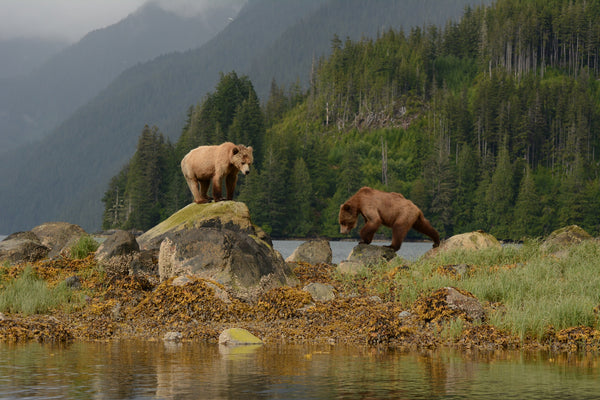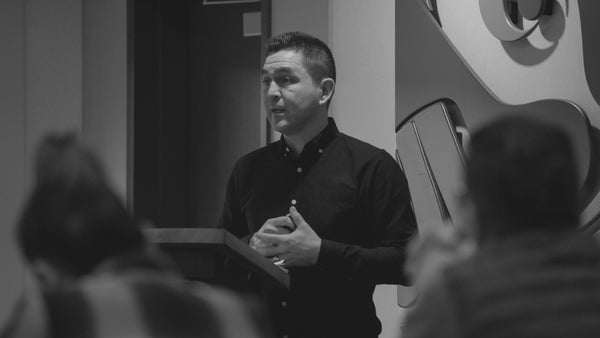Can Orphaned Grizzly Cubs Build a Den Without Their Mother?
In the fall of 2020, grizzly bear cubs Arthur, Raven, and Isa were tragically orphaned at only nine months old. The triplets were rescued and returned to the wild in the spring of 2021 thanks to the efforts of the Northern Lights Wildlife Society and the BC Conservation Officer Service. Supported by the Grizzly Bear Foundation and led by Independent Research Scientist Dr. Lana Ciarniello, Project Rewild is a world leading research program for orphaned grizzly bear cub rewilding efforts. As we continue to follow their progress, journey with us to learn how Arthur, Raven, and Isa survived their first winter on their own.
One of the most exciting findings for Project Rewild so far was learning that Arthur, Raven, and Isa all denned together and made it through the winter! As Grizzly Bear Foundation’s Outreach & Communications Manager and the Principal Technician for Project Rewild, I had the amazing opportunity to join Dr. Lana Ciarniello on her mission out of Bella Coola this past spring, where we saw firsthand where the three siblings spent the winter. Tragically orphaned at just nine months old, Arthur, Raven, and Isa never got the chance to observe their mother excavate a den site. Without their mother, would they know what to do come winter time? Would they find enough food and adequate shelter to make it through the winter?
Project Rewild has been working hard to answer these questions and more as we follow the individual journeys of rewilded orphaned grizzly bear cubs. With the help of GPS collars, we’ve been able to monitor their success and survival in the wild with enlightening detail: following their movements and habitat use across the landscape, getting down on the ground to identify wild bear foods they’ve utilized, and now, locating successful denning sites!

My First Time Inside a Wild Grizzly Bear Den
I’d packed boots with good tread and a spirit for bushwhacking - two Project Rewild trip essentials. We departed Bella Coola in the morning with clear skies, and after a thirty minute flight we were dropped by helicopter in a remote location in the heart of the Great Bear Rainforest. Using only a compass and GPS maps downloaded to an iPad, we began the steep descent towards the den site. It took us about two hours to reach the den, which the young grizzlies excavated under a big rotting tree stump. We noticed bear hairs clung to the den entrance, exciting evidence of their presence. The den was quite stable, with both rock and roots as stabilizing structures, and there was no pooling water. It was very dry inside - critical for a warm and cozy winter. Plus, the bears had pulled in lots of Western Hemlock tree boughs, the preferred bedding material for a grizzly bear mattress! Perhaps something they remembered from their short time with their mothers.
The den was much smaller than I would have expected for three bears of their size, and it was indeed not quite big enough to completely fit all of them inside. It appeared they tried to make the den chamber bigger but hit a rock wall. Another interesting observation is the elevation they denned at - about 650 metres - which is more typical for black bears. Grizzlies usually den at higher elevations in the subalpine/alpine.
“You know, they really tried to do it right. As we could see inside of the den, they hit a big rock wall. So they did try to excavate back into that to make the chamber bigger, but they couldn't, because they hit rock. So then they tried to excavate up. But that didn't work either. I think they were maybe trying to do a multistage den which I've also seen before, like a multi chamber den. But that didn't work because when they went up then they hit a bunch of root material. So they went with what they had because this was their second den attempt in this area - we found another one that they actually abandoned because they hit full rock and couldn't excavate back further. So I think that they did quite well given the situation, given that this is the first time they've had to make it on their own. A section of the den was partially collapsed and ideally the den would have been bigger to have fit all three bears completely inside, but they made the best with what they had. It was great to see that the den itself was quite dry and they had pulled in lots of bedding material for a thick mattress. It was a good attempt! Not the best den, but definitely not the worst!” - Dr. Lana Ciarniello, Independent Research Scientist leading Project Rewild
This was Dr. Ciarniello’s 90th bear den investigation. Black bears and grizzly bears, from rock dens to tree dens to dens excavated on steep alpine slopes, Dr. Ciarniello has seen dens of all shapes and sizes. It was a fast-paced learning experience for me to assist and observe her conduct an investigation on the orphaned cubs’ den. All things considered, the triplets built a pretty good den on their own and it helped them survive through the winter. Seeing their den firsthand was incredibly fascinating, humbling, and yet another experience that has deepened my admiration for grizzly bears, demonstrating their intelligence, resourcefulness, and resilience.

The information we’ve gained helps tell the story of what orphaned grizzly cubs are capable of, providing insight into the question of nature vs. nurture. What do grizzly bear cubs learn from their mother, how much is innate, and what can they figure out on their own? What rewilding best practices could enhance their learning?
To feel the comfort of the thick mattress of tree boughs on the den floor, to smell the earth as loose soil and roots dangled from the den ceiling, I could for a moment immerse myself in the lives of these orphaned cubs, and truly appreciate the work we are doing here at the Grizzly Bear Foundation for the welfare and conservation of these amazing animals.
Improving our understanding of the success and survival of rewilded orphaned grizzly cubs is critical to inform policy and rewilding best practices. With a scientific approach, the Grizzly Bear Foundation is working to ensure we have the best available information to make informed decisions for the care and welfare of orphaned grizzly bear cubs in B.C. and beyond.
Not only will the results of this research inform the fate of individual bears, but it could also contribute to the conservation of threatened and recovering grizzly bear populations across North America, with global implications. But first, we need the science. And we can’t do it without you.
Become a Project Rewild Supporter

Taylor Green
Outreach & Communications Manager, Grizzly Bear Foundation
Principal Technician, Project Rewild
Leave a comment
Comments will be approved before showing up.



